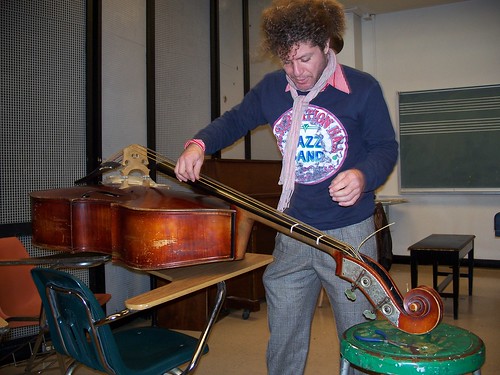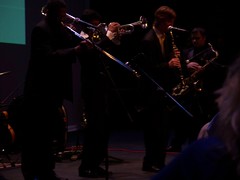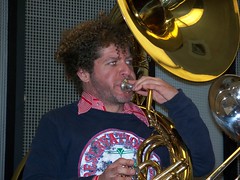
Bassist and Director of New Orleans’ Preservation Hall, Ben Jaffe, appeared at the USF Monday Night Jazz Series on Monday 24 February 2007. Every Monday Night Jazz program this year has been excellent, but this one was by far the best for a multitude of reasons.
Being a bass player, I was excited to have a bass player come to do MNJ and give a masterclass after the semester of trumpets. I wasn’t, however, entirely sold on the idea of a MNJ devoted to New Orleans Jazz. I am not into trad jazz of any sort and, though I understand its importance in developing my jazz world view and that the music I tend to play wouldn’t exist without it, I just don’t really enjoy listening to it; it’s not my typical choice for “cruise” music.
 I picked Ben up from the hotel Monday morning so he could get acquainted with his bass-for-a-day. Right off the bat, I was sold. Ben is much younger than my preconceived notions of a Preservation Hall guy and has far-reaching interests (musical and otherwise) that reminded me that we can only pigeon-hole ourselves. Not only that, but he’s also a gut player. I had just put wound gut (Pirastro Olives) on my bass last week, an old set that I had removed from another bass years ago, and was experimenting with that sound. Ben didn’t travel with his bass, but asked, instead, for any old bass, as long as it has adjusters. For most people, bridge adjusters are used to ensure the action is low enough to make a bass comfortable to play. For Ben, it was to ensure he could get his action high enough!
I picked Ben up from the hotel Monday morning so he could get acquainted with his bass-for-a-day. Right off the bat, I was sold. Ben is much younger than my preconceived notions of a Preservation Hall guy and has far-reaching interests (musical and otherwise) that reminded me that we can only pigeon-hole ourselves. Not only that, but he’s also a gut player. I had just put wound gut (Pirastro Olives) on my bass last week, an old set that I had removed from another bass years ago, and was experimenting with that sound. Ben didn’t travel with his bass, but asked, instead, for any old bass, as long as it has adjusters. For most people, bridge adjusters are used to ensure the action is low enough to make a bass comfortable to play. For Ben, it was to ensure he could get his action high enough!

Ben put and unwound G and D on one of the University’s old Juzeks and kept tuning it for the next several minutes while we talked. He left them almost a third above pitch and, by the masterclass half an hour later, they had dropped well over a fifth! I can see why steel strings were welcomed by the bass community with open arms.




The masterclass centered around a combo that had prepared some music specifically for this event. Ben talked about the differences between Dixieland and New Orleans Jazz and about the roots of the music, about Jazz Funerals and Mardi Gras. His father had played tuba in the band, a mantle which Ben was plenty capable of taking on himself. He worked with USF bassist John Shea on slap technique and drummer Mark Feinman on the timbres native to this NOJ tradition.
 The evening’s concert was the first in a series of programs the Univeristy is doing for the Looking at Jazz Series. The concert was opened by the same combo from the day’s masterclass performing at USF Theatre II during the serving of light hors d’ouvres and cocktail tables decorated in a 1920′s theme.
The evening’s concert was the first in a series of programs the Univeristy is doing for the Looking at Jazz Series. The concert was opened by the same combo from the day’s masterclass performing at USF Theatre II during the serving of light hors d’ouvres and cocktail tables decorated in a 1920′s theme.
During this time and throughout the concert, videos of early jazz were being projected behind the band. After the combo went on, Ben provided commentary on some of the videos he had brought from his personal collection. These were extraordinary videos about Preservation Hall and Jazz Funerals.
The main event featured the faculty jazz combo with the exception of drummer Steve Davis, whose spot was covered by USF alumnus Ian Goodman. They covered Do You Know What it Means to Miss New Orleans?” and other classic New Orleans tunes. The highlight for me was Jaffe and Wilkin’s statement on Gershwin’s I Got Rhythm, a recreation of the famous Don Byas|Slam Stewart Town Hall recording.
I found this MNJ concert and Ben Jaffe to be extremely inspiring and have decided to devote a portion of my study/practice to understanding more traditional forms of bass playing. To that end, I will be using the school Juzek (strung with all guts) and have ordered How Low Can You Go?, a three-disc collection chronicling the double bass in early music.

